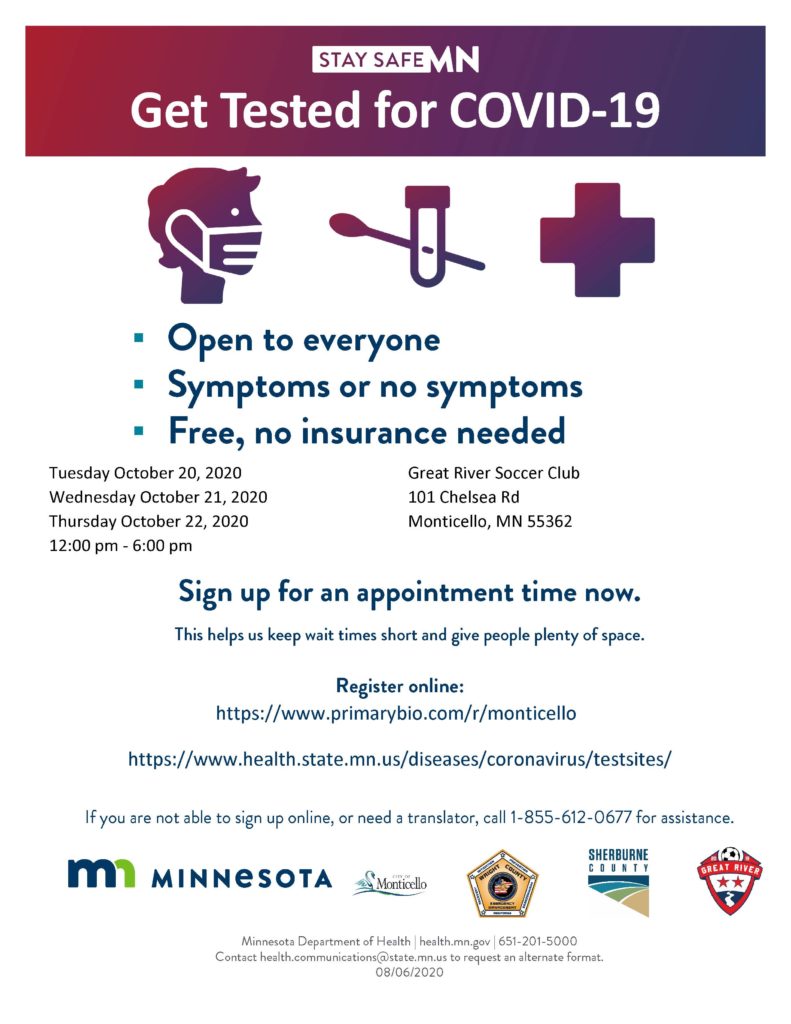BUFFALO, MN – The Minnesota Department of Health is partnering with local public health officials to give people a chance to get a COVID-19 test if they would like to get tested. The testing event in Monticello will be Tuesday, October 20 through Thursday, October 22. Testing is free, available to anyone who feels they need to be tested whether or not they have symptoms and will not require insurance.
Sarah Grosshuesch, Wright County Public Health Director, encouraged the Wright County community to get tested, stating that “access to testing is an important tool in getting ahead of the coronavirus that causes COVID-19.”
Communitywide testing can help protect vlunerable patients, as well as help the community keep businesses and schools open, she added.
“This testing will help guide our efforts to combat COVID-19 and protect those who are most vulnerable to serious complications. We want to thank our partners for coming together to help provide this resource for our community,” Grossheusch said.
 Many who contract COVID-19 may experience mild or even no symptoms, but some suffer life-threatening complications. All who contract the virus are contagious. Getting tested helps people know they if have contracted COVID-19 so they are informed and can protect those they are close to who might be most vulnerable to serious complications. This is a proven strategy for fighting spread of a virus like COVID-19.
Many who contract COVID-19 may experience mild or even no symptoms, but some suffer life-threatening complications. All who contract the virus are contagious. Getting tested helps people know they if have contracted COVID-19 so they are informed and can protect those they are close to who might be most vulnerable to serious complications. This is a proven strategy for fighting spread of a virus like COVID-19.
Here are the details of the testing in Monticello:
Date: Tuesday, October 20, Wednesday, October 21, and Thursday, October 22
Time: Noon to 6 p.m.
Where: Great River Soccer Club Indoor Facility, 101 Chelsea Road, Monticello, MN 55362
To avoid long lines, community members are encouraged to pre-register for a time slot. Visit this website for more information and to sign up for an appointment. Those who are unable to sign up online or need interpretation can call 1-855-612-0677 for assistance.
Increased access to testing and identifying positive cases as early as possible is a critical way to keep schools and the economy as open as possible. Positive cases staying hidden leads to more spread and more detrimental impact to our schools and economy. Switching from one learning model to another is a complicated calculation that can be very disruptive and requires significant planning. School districts balance the important benefits of in-person learning to the mental and emotional health of their students with the very real risk of COVID spread in a school environment.
Now that school has opened, broad community level data alone does not directly determine a potential change to the learning model. Instead, cases within the school community and what is happening in the schools themselves are the most important considerations. Any decision to change the model is made by the school district in consultation with a local support team, including local public health, the Minnesota Department of Health, and the Minnesota Department of Education.